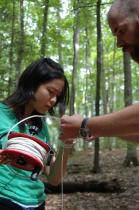Penn State researchers ‘whet’ teen students’ interest in water cycle
http://live.psu.edu/story/47937/nw69
Sunday, August 22, 2010
Penn State researchers ‘whet’ teen students’ interest in water cycle

Photo by Margaret Hopkins In Pun, a rising ninth grader at State College Area High School, gets help from George Holmes, Penn State graduate student in civil engineering, on how to read an electronic water-level sensor. For more photos from the Stone Valley streambed ‘lab,’ click on the image above.
University Park. — A dry streambed in a small wooded valley near Penn State’s Stone Valley Recreation Area became a “living” laboratory Wednesday (Aug. 18) for a group of State College Area High School students getting an early taste of earth science.
Using soil moisture probes and water-level sensors, the teens sampled 16 sites to determine the depth of the water table and the moisture content along a streambed that was so dry in parts that it was almost dusty. The laboratory was the 20-acre Shale Hills watershed in the Penn State Stone Valley Experimental Forest in Huntingdon County.
Instructing the students was Chris Duffy, Penn State professor of civil engineering, who is the lead researcher in the NSF-sponsored Susquehanna Shale Hills Critical Zone Observatory (CZO). Critical Zone science explores the complex physical chemical and biological processes that shape and transform the life-sustaining Critical Zone stretching from the top of vegetation to the bottom of groundwater.
Researchers in three Penn State colleges, Engineering, Earth and Mineral Sciences and Agricultural Sciences, are involved in examining water flow patterns and rates as it moves through the subsurface of the Shale Hills watershed.
A new initiative for the State College Area School District, the STEM (Science, Technology, Engineering and Math) academy is emphasizing hands-on activities with students building instruments, conducting experiments and analyzing data.
“When kids see and do hand-on things, they remember it far better than being told what it is and how it works,” said Wendy Watts, who teaches physics in the school district and who also took a turn measuring soil moisture with the students.
The students’ measurements confirmed their hypotheses: Soil on the banks of the stream was drier than the soil in the streambed, and soils are drier closer to stream headwaters.
“Doing experiments and seeing how it works in person helps me learn it better,” said 14-year old In Pun, one of the 10 students in the State College Area School District’s week long STEM Summer Academy. “I’m really understanding how the water cycle works and how everything affects it.”
Amer Sible, 14, said, “This helps me make connections between the everyday things you see and the science behind them.”
Dave Klindienst, the district STEM coordinator, said the district is looking to build more collaborations with Penn State, a goal that also fits well with Duffy.
“If we want to move Critical Zone Observatories forward as a national network, we need education at the K-12 level in the mix,” Duffy said. “Today was an opportunity for students to learn about ecology, geology and hydrology with mentors.”
